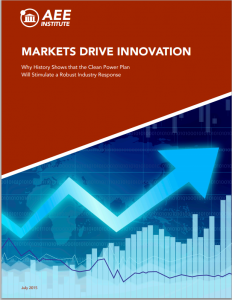Full Title: Markets Drive Innovation: Why History Shows that the Clean Power Plan Will Stimulate a Robust Industry Response
Author(s): Advanced Energy Economy
Publisher(s): Advanced Energy Economy
Publication Date: July 1, 2015
Full Text: Download Resource
Description (excerpt):
On June 2, 2014, the Environmental Protection Agency (EPA) proposed the Clean Power Plan (CPP) to implement section 111(d) of the Clean Air Act (CAA).1 While the proposed rule does not mandate a marketbased approach to compliance, ample evidence from previous CAA rules suggests that market-based mechanisms are likely to develop under the CPP, and that these mechanisms will spark an industry response that will make available a wide array of cost-effective compliance options.
Past Rules Show that Market-Based Mechanisms Unleash Industry Response By setting a regulatory signal and allowing for market-based compliance mechanisms, EPA rules have initiated the development of active and efficient markets in reducing the lead content in gasoline, combating acid rain, and controlling regional transport of ozone due to emissions of sulfur dioxide (SO2) and nitrogen oxides (NOx). These prior regulatory programs offer strong evidence that industry responds rapidly and effectively to regulatory signals set by EPA when market-based compliance mechanisms are allowed, enabling the development and delivery of a wide array of compliance solutions at low cost.
The successful development of efficient and active markets under these programs is demonstrated by the widespread use of trading by affected entities, the use of credit banking where available, and the lack of volatility in market prices for emission allowances. The development and use of markets for emission allowances under these programs provided affected entities with a range of cost-effective emission reduction measures to choose from. As a result, emissions were reduced more quickly than required, compliance costs were significantly lower than expected, and well-functioning private markets in pollution-reducing technologies evolved rapidly in response to the EPA rules.
